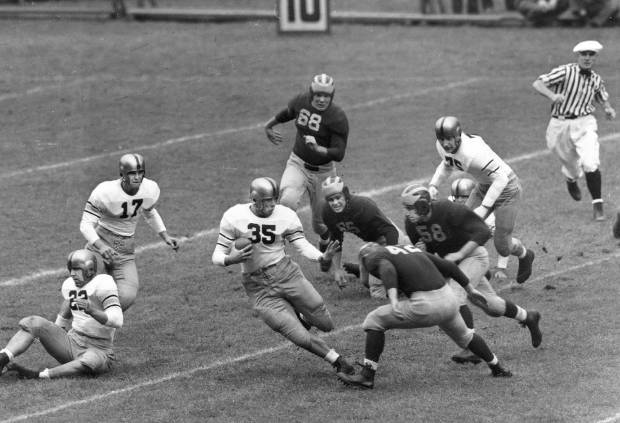


| Louisville Field | 32-0 | |
| Wake Forest (5-3-1) | 54-0 | #19 |
| (Bronx) Michigan (7-3) | 28-7 | #6 |
| Melville PT Boats | 55-13 | |
| (NYC) Duke (6-2) | 48-13 | #9 |
| Villanova (4-4) | 54-0 | |
| (Bronx) Notre Dame (7-2-1) | 48-0 | #8 |
| at Penn (6-2) | 61-0 | #7 |
| (Philadelphia) Navy (7-1-1) | 32-13 | #3 |
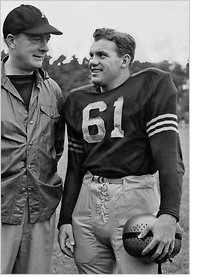 This
team was practically the same as Army's equally dominating MNC winner
from the year before, and I covered their Hall of Fame coach Red Blaik and
most of the players in my 1944 national championship article.
They lost a pair of nonconsensus All Americans from that team, guard
Joseph Stanowicz and Hall of Fame quarterback Doug Kenna, but everyone
else I listed in the 1944 article returned, and they replaced Kenna
this season with another Hall of Fame quarterback, Arnold Tucker.
This
team was practically the same as Army's equally dominating MNC winner
from the year before, and I covered their Hall of Fame coach Red Blaik and
most of the players in my 1944 national championship article.
They lost a pair of nonconsensus All Americans from that team, guard
Joseph Stanowicz and Hall of Fame quarterback Doug Kenna, but everyone
else I listed in the 1944 article returned, and they replaced Kenna
this season with another Hall of Fame quarterback, Arnold Tucker.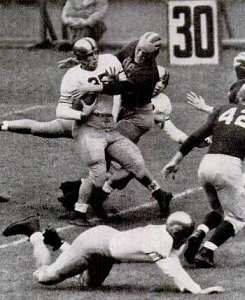
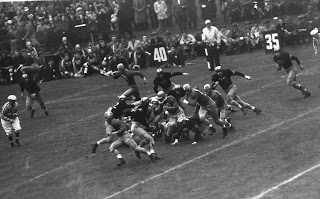
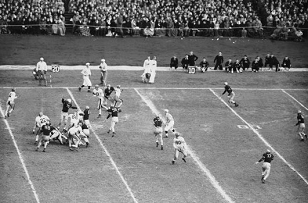
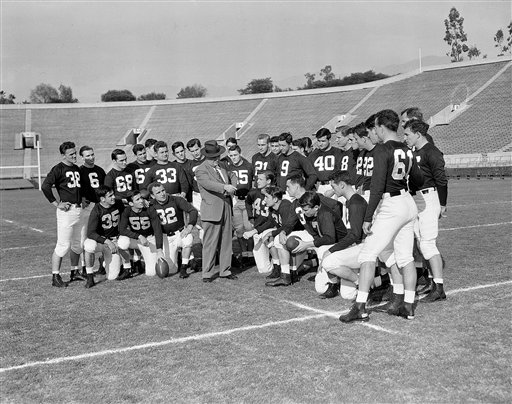
| at Keesler Field | 21-0 | |
| at Louisiana State (7-2) | 26-7 | #12 |
| (Montgomery) South Carolina (2-4-3) | 55-0 | |
| Tennessee (8-1) | 25-7 | #10 |
| Georgia (9-2) | 28-14 | #13 |
| at Kentucky (2-8) | 60-19 | |
| at Vanderbilt (3-6) | 71-0 | |
| Pensacola NAS | 55-6 | |
| Mississippi State (6-3) | 55-13 | |
| Rose Bowl Southern Cal (7-4) | 34-14 | #21 |
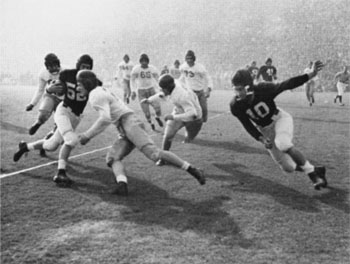
| Army 9-0 | Alabama 10-0 | ||||||||||||||||||||||||||||||||
|---|---|---|---|---|---|---|---|---|---|---|---|---|---|---|---|---|---|---|---|---|---|---|---|---|---|---|---|---|---|---|---|---|---|
|
|
||||||||||||||||||||||||||||||||
| 1) Boand
(math system) College Football Researchers Association |
5.0 |
| 3) AP Poll Poling (math) Billingsley (math) |
4.92 |
| 6) DeVold (math) | 4.89 |
| 7) National Championship Foundation | 4.64 |
| 8) Litkenhous (math) | 4.57 |
| 9) Houlgate (math) | 4.4 |
| 10) Dunkel (math) | 4.12 |
| 11) Sagarin (math) | 4.07 |
| 12) Helms Foundation | 4.04 |
| 13) Berryman (math) | 4.03 |
| 14) Sagarin-ELO (math) | 3.9 |
| 15) Williamson (math) | 3.3 |
| 16) Dickinson (math) | 3.0 |
| 1) Boand (math system) | 4.26 |
| 2) College Football Researchers Association | 4.22 |
| 3) Poling (math) | 4.11 |
| 4) Helms | 4.09 |
| 5) Sagarin-ELO (math) | 4.06 |
| 6) National Championship Foundation | 3.96 |
| 7) Dickinson (math) | 3.49 |
| 8) Houlgate (math) | 3.35 |
| 9) Billingsley (math) | 3.34 |
| 10) Sagarin (math) | 3.28 |
| 11) Parke Davis | 2.77 |
| 1) Houlgate (math system) | 4.5 |
| 2) Helms | 4.3 |
| 3) Parke Davis | 4.2 |
| 4) National Championship Foundation | 3.7 |
| 5) Billingsley (math) | 3.6 |